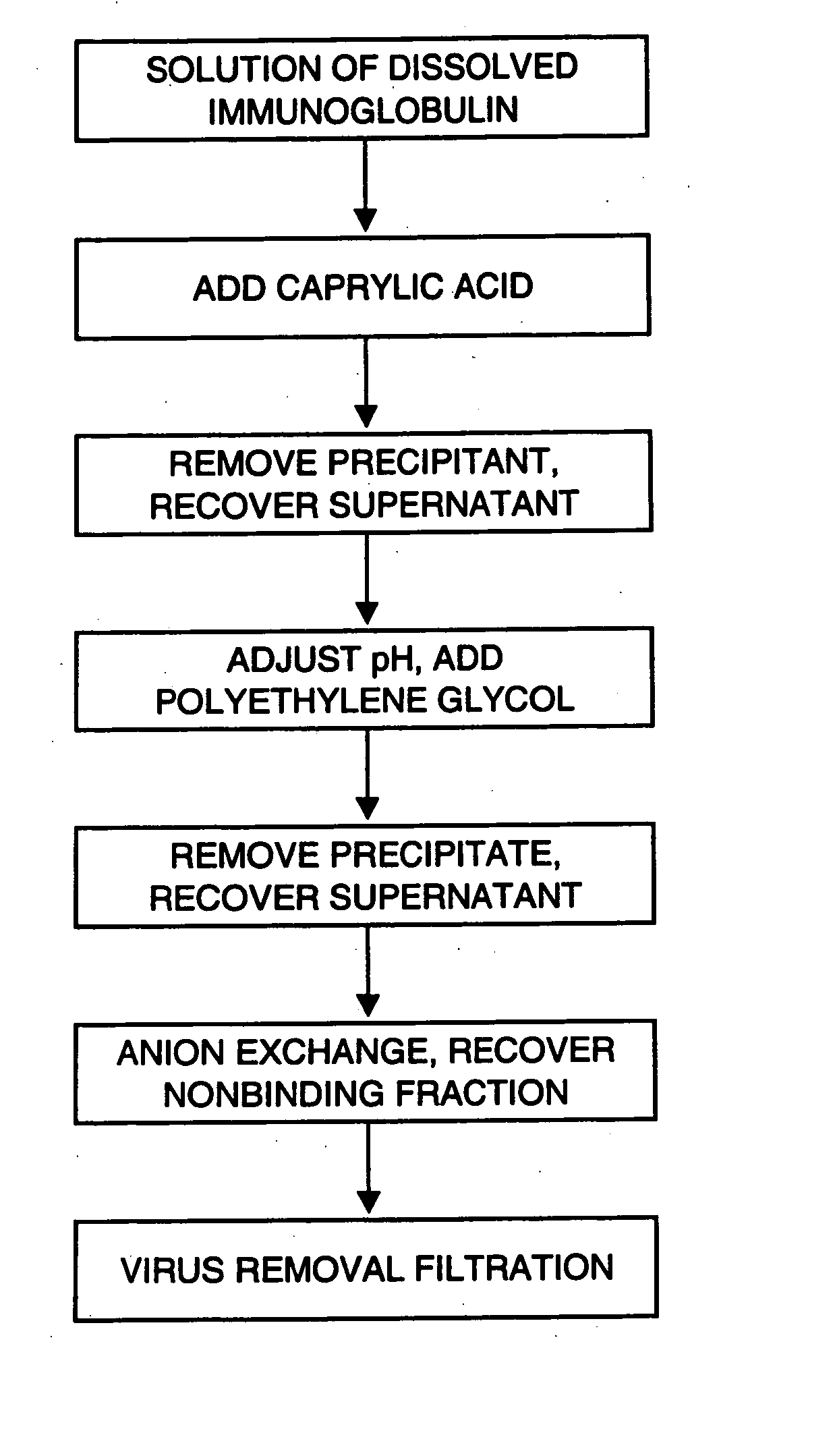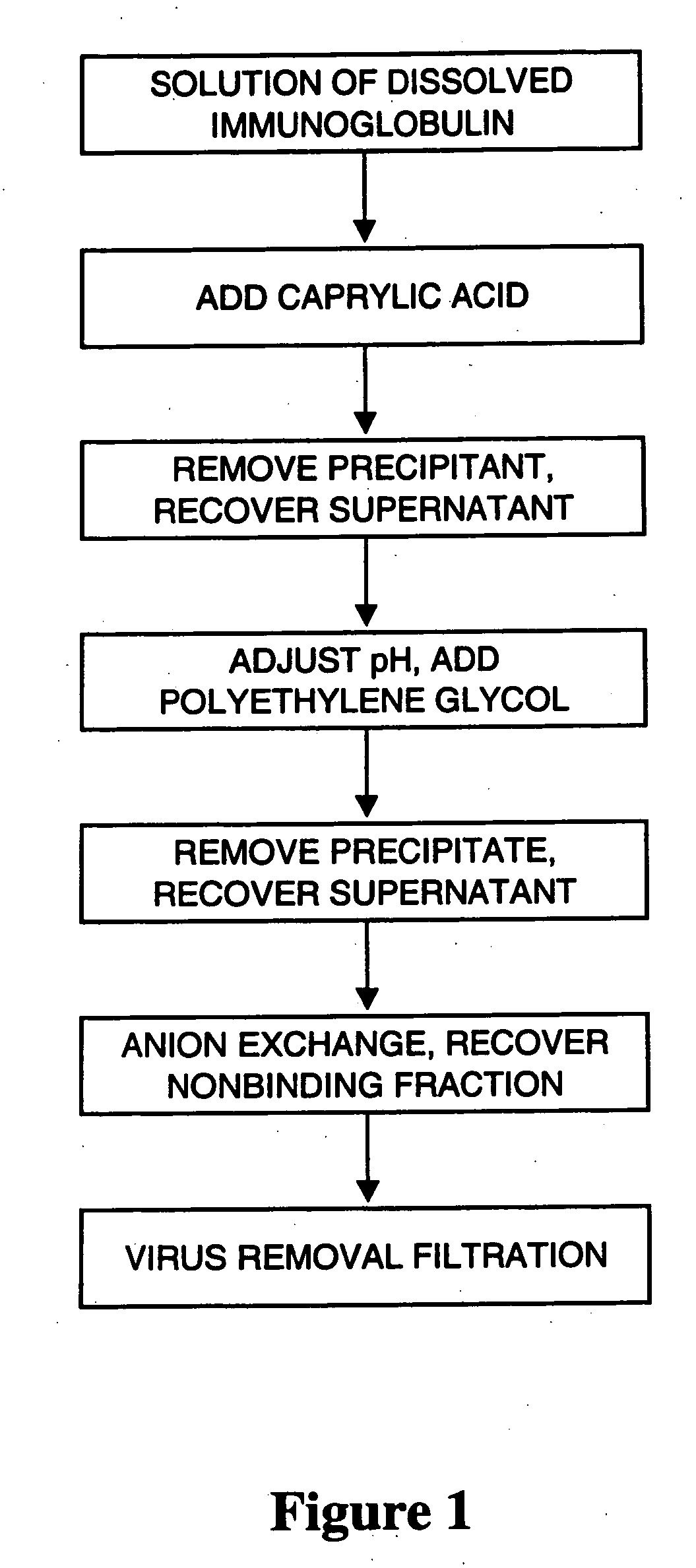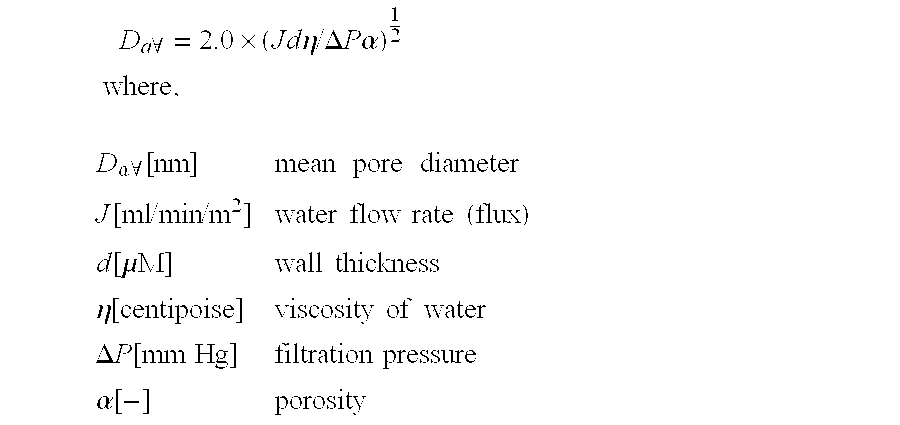Process for The Manufacture of Virus Safe Immunoglobulin
a technology of immunoglobulin and production process, which is applied in the field of production of immunoglobulins, can solve the problems of reducing the yield of immunoglobulin
- Summary
- Abstract
- Description
- Claims
- Application Information
AI Technical Summary
Benefits of technology
Problems solved by technology
Method used
Image
Examples
example 1
[0065] This example describes manufacturing of aggregate-free and virus-safe immunoglobulin from human plasma with high yield.
[0066] Fraction II+III paste from human plasma was fractionated by the Cohn method (Krijnen, Chemie en Techniek 25,193-196, 1970). 500 g of fraction II+III paste was suspended in 8 volumes of purified water at about 5° C. and the pH was adjusted to 4.8 with 0.2 mol / l acetic acid. The suspension was brought to room temperature (about 22° C.). Caprylic acid was added to a concentration of 50 mM during 1 hour. The suspension was mixed for I hour and the precipitate was removed by centrifugation. The pH of the solution was raised from 4.5 to 5.4 with 0.2 M NaOH, 30 g / l of PEG 4000 was added and the solution was mixed for 16 hours. 2% of diatomaceous earth was added and the mixture was filtered. The solution conductivity was adjusted to 2.0 mS / cm using sodium acetate buffer. The filtrate was applied to a column of ANX Sepharose FF gel equilibrated with 20 mM sodi...
example 2
[0068] This example demonstrates reduction of parvovirus B19 in the manufacturing process described in Example 1.
[0069] Virus reduction in each process step was studied by spiking the starting solution with high-titer parvovirus B19 positive plasma. Nucleic acids were isolated from the starting solution and processed samples diluted in parvovirus-negative plasma with the Roche MagNA Pure method. The amount of parvovirus B19 DNA was determined by real-time PCR using the Roche Lightcycler and the Roche Parvovirus B19 Quantitation Kit. The reduction of parvovirus in the different process steps is shown in Table 2.
TABLE 2Reduction of parvovirus in the process steps.Reduction factorProcess steplog 1010Caprylic acid precipitation1.7PEG precipitation4.8ANX chromatography2.0Virus filtration4.1Total reduction factor12.6
example 3
[0070] This example demonstrates the importance of a specific polymer removal step for efficacious virus filtration. A crude immunoglobulin solution was prepared and treated with caprylic acid as described in Example 1. The pH of the supernatant solution was raised to 5.4. In separate experimental batches different amounts of polyethylene glycol (PEG 4000) or no PEG was added to the supernatant solution. The solution was mixed at room temperature for 16 hours, 2% diatomaceous earth was added and the solution was clarified by filtration. The clarified solution was subjected to anion exchange chromatography on ANX Sepharose and the effluent containing purified IgG was recovered. The pH of the effluent solution was adjusted to 4.4. After prefiltration with a 0.1 μm filter, the solution was filtered with Viresolve NFP (Millipore) filter with a pressure of 3.5 bar at 35° C. Protein concentration was about 8 g / l and a load of about 10 kg IgG / m2 filter area was used. Filtrate flux was moni...
PUM
| Property | Measurement | Unit |
|---|---|---|
| Temperature | aaaaa | aaaaa |
| Weight | aaaaa | aaaaa |
| Weight | aaaaa | aaaaa |
Abstract
Description
Claims
Application Information
 Login to View More
Login to View More - R&D
- Intellectual Property
- Life Sciences
- Materials
- Tech Scout
- Unparalleled Data Quality
- Higher Quality Content
- 60% Fewer Hallucinations
Browse by: Latest US Patents, China's latest patents, Technical Efficacy Thesaurus, Application Domain, Technology Topic, Popular Technical Reports.
© 2025 PatSnap. All rights reserved.Legal|Privacy policy|Modern Slavery Act Transparency Statement|Sitemap|About US| Contact US: help@patsnap.com



